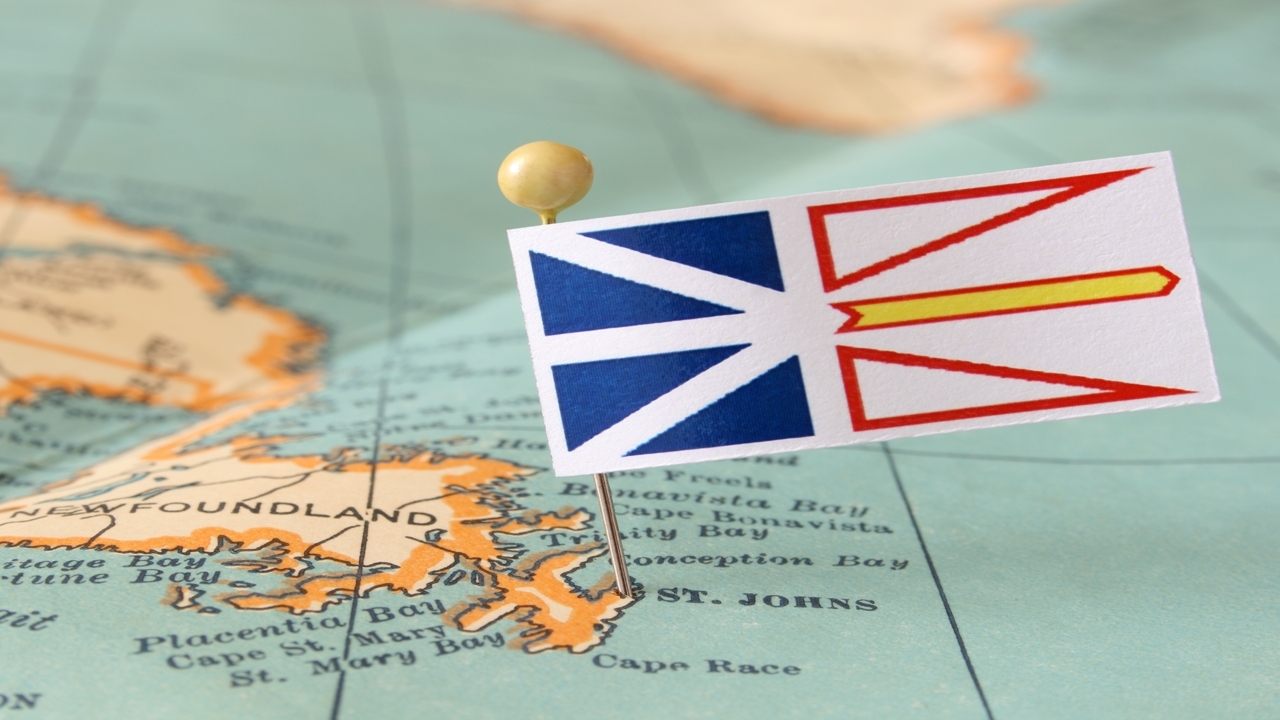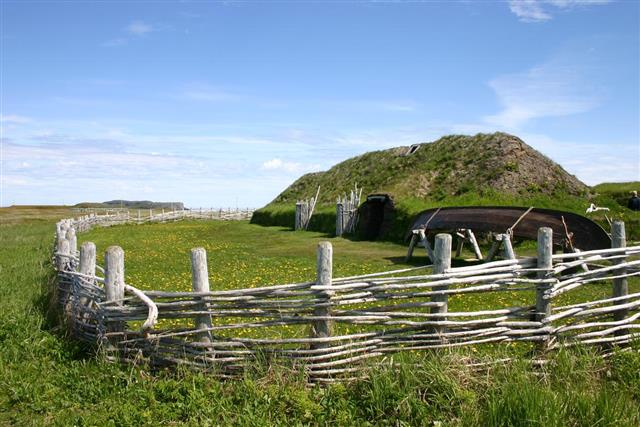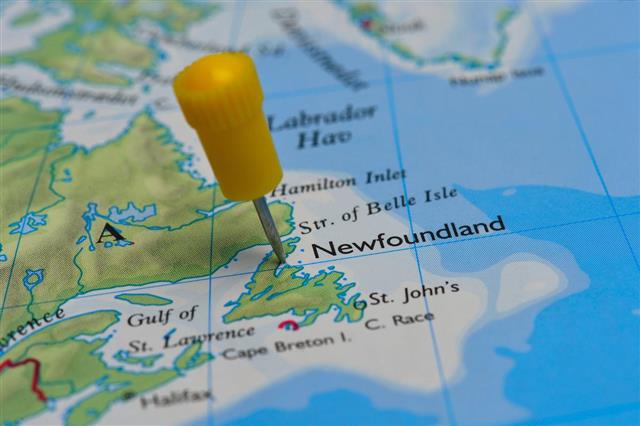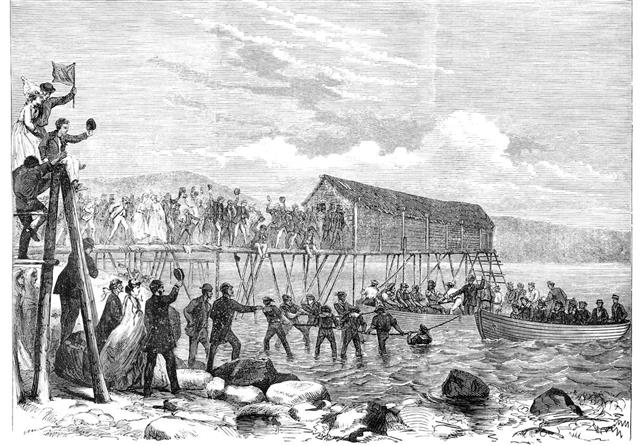
The Beothuks were the indigenous people of Newfoundland who were displaced and finally annihilated by the subsequent advent of the Micmacs, a tribe from Mainland Canada, and of the Europeans.
Newfoundland and Labrador is the eastern-most Canadian province situated midway between North America and Western Europe. Newfoundland Island lies in the Bay of the St. Lawrence River and Labrador is connected to the Canadian mainland. The total area, 111,390 sq km for Newfoundland and 294,330 sq km for Labrador, is larger than that of Great Britain, and still possesses an extensive, unspoiled wilderness that is home to animals like Caribou, Moose, Polar Bears, Black Bears, Martens, Hares, Otters, Beavers, and Wolves.
Originally populated by indigenous people until the arrival of the Vikings, who established the settlement at L’Anse aux Meadows, the Provinces were later discovered by the Venetian John Cabot. He sailed into Cape Bonavista in 1497 and was followed three years later, on St. John’s Day, by the Portuguese explorer Gaspar Corte Real, who named his landing place after the Saint. Their accounts of the land and its abundant resources soon brought an onslaught of other Europeans, and harbors to serve as bases for the summer fishery were set up all along the Eastern Coast from Cape Bonavista to Cape Race.
Substantial cod and whale fishery was carried out by the Portuguese, the Spaniards, the French and the Basques, but their seasonal trade seemed to have precluded the idea of any permanent settlements. This was left to the English under King Henry VIII, and the first English Colony came about in 1527. The English were also the forerunners in the first postal exchange from the new region; this came about when the explorer John Rutt sent home a missive on a returning ship. Another Englishman, John Guy, pioneered a plantation in Cupid’s Cove in 1610. His wife was the one who taught English to the famous American Indian, Squantum, who later on, in the course of his rather interesting and eventful life, proved to be of invaluable assistance to the Mayflower Settlers.
Another interesting character, exceedingly unpopular with the traders, was the infamous pirate Peter Easton. More English settlers arrived soon and many new English plantations were set up. The French now woke up to the need of both protecting their fishing trade and maintaining their presence in Newfoundland, and, by the orders of the then reigning Louis XIV, the first French Colony was founded at Placentia in 1662. The establishment of both English and French settlements was stoutly opposed not just by each other, but also by the ship fishermen who wanted the Provinces to remain solely fishing preserves. The ensuing strife and agitation lasted for a very long time, and the settlers, suffering much harassment, were not able to get legal rights until 1811.
Self-government came in 1855, the first train in 1899, and the first newsprint mill in 1908. Later the Provinces provided the base for the first trans-Atlantic telegraph, the first trans-Atlantic air-crossing, and the first trans-Atlantic wireless broadcast. The fishing industry bonanza during the First World War brought great prosperity, but, with the Great Depression, hardships and unemployment followed on a massive scale. It took another World War and the installment of American troops here in its course for the economy to recover, and the standard of living once again went up. But the Newfoundlanders had learned from their experiences and, deciding they would be better off in the long run if they joined Canada, they did so in 1949.
As has been the case in most parts of the world throughout history, the success of the new arrivals unfortunately undermined the existence and rights of the original inhabitants. The Beothuks were the indigenous people of Newfoundland who were displaced and finally annihilated by the subsequent advent of the Micmacs, a tribe from Mainland Canada, and of the Europeans.
Probably the people that the Vikings described as the ‘Skraelings’, the Beothuks were descended from the Algonquian-speaking tribes of the Canadian Northeast, spoke a related language, and in appearance were of above-average height, with light brown skin, dark hair and eyes. The term ‘Red Indian’ was first used in reference to them on account of their practice of anointing themselves and their belongings with a mixture of tallow and the abundantly found iron-rich soil called red ochre. This was a mark of tribal identity into which an infant was initiated shortly after birth and a ceremonial application followed every year after that. It probably was supposed to invoke the protective or supernatural powers that they believed in like the sun, the moon, the ‘Great Spirit’, the ‘Powerful Monster’ from the sea and Aich-mud-yim, or ‘Black Man’.
Since the Beothuk language is related to the Algonquian, it is assumed that their religious beliefs and rituals too were similar to those of the Algonquian tribes. These consisted mainly of respecting all animate and inanimate objects in nature as spiritual beings, and believing that they themselves originated from an arrow striking the ground. Weddings were celebrated with much feasting and, as far as is known, Monogamy was practiced. The decorative bone pendants and some bowl-and-dice gaming pieces that have been found probably had religious significance aside from the entertainment one.
The Beothuks were hunters and fishermen, who traditionally made two annual migrations to the sea coast and the interior forests to avail of the seasonal food resources available in these areas, and who were in the habit of keeping aloof from other people, fiercely guarding their privacy and independence. This is the reason there is so little detailed knowledge about them today. The information we have now comes mainly from the letters and travel accounts of the Europeans of that period and from the few Beothuks that they managed to capture, like the young woman Shawnadithit or Nancy as she was renamed, Demasduit or Mary March, another one called Oubee and a few others.
These latter sources, however, could neither provide extensive information due to both language and communication problems, nor did they agree to assist some of the fair-minded Europeans in establishing peaceful contacts with their tribe since it was the tribal principle to kill any member that had lived with the hated enemy. One reason for this was that the Beothuks had come to believe that the Europeans originated from a bad spirit that would affect anybody that interacted with them; and another reason was the belief that by sacrificing the tribe members so-afflicted the souls of those wantonly killed by the enemy would be assuaged.
Other information has been obtained by Archaeologists from the excavated Beothuk village and burial sites. These latter have mostly been found along the sea-coast, the dead wrapped in birch rind and interred in various ways. In one, the body along with its earthly belongings was placed on a tall platform, and in another the body was bent together and enclosed in a box made of birch logs. Various items of everyday use have been found in most of these graves as the Beothuks believed that these would be needed on the journey to the island of the ‘good spirit’. Those left bare can be surmised as belonging to the Beothuks that had been sacrificed to the spirits of the dead (for making peace with the Europeans or the Micmacs) and so were barred from this island. Anyway, an idea of Beothuk life can be had from these places and the artifacts found.
The Beothuks mainly subsided on a meat diet, either eaten raw or boiled or roasted on a fire made by the friction of iron pyrites. On the Coastal area, in Spring and Summer, they hunted Seals, Sea Duck, Cormorant, Black Bears, Whales, and Seabird Eggs. For this they used long, curve-ended canoes of slat-frameworks and leather coverings. In the Fall, when the Caribou Herds migrated, they moved inland and maintained mile-long ‘deer fences’ that directed the herds to specific hunting areas. Small game such as beaver, fox and ptarmigan were also hunted in this period, but the Caribou was the animal of prime importance. Its meat was preserved for the coming winter, and its skin used for a variety of useful purposes like making clothing and the coverings for their shelters, the ‘Mamateeks’, and the canoes. Various natural remedies derived from the surrounding forest as well as vapor baths were used for medicinal purposes.
The Beothuk dress was a simple, sleeveless tunic of stitched-together skins that sometimes came with a hood. Together with this, they sometimes wore Caribou-skin leggings, arm coverings and moccasins. All these items were usually decorated with frills and painted with red ochre. Elaborately carved and incised bone and ivory pendants were worn either as decorative jewelry or as talismans of guardian spirits.
There are no definite details about the Coastal habitats of the Beothuks. From the pits found in Bonavista Bay, it is assumed they were probably round-shaped. Better known are the winter habitats, the ‘Mamateeks’, which were conical structures constructed of straight fir poles that met at the top, leaving a central smoke hatch. This framework was mainly covered Caribou skin, but birch bark and cloth, if available, was often used too. The gaps were filled with moss and clay, and soil heaped on the outside edges to keep out the wind and snow. The Mamateeks were of various sizes and often multi-sided.
Of prime importance inside was the fireplace for cooking and for keeping the inhabitants warm; they usually slept around it in dug-out sleeping pits. Crisscrossed beams above store the winter provisions and the weapons were hung within easy access on the walls. There were various types of weapons – bows and arrows, spear, harpoons – later on scavenged European utilitarian articles like fish-hooks, nails, scissors, spoons, forks and so on were also ingenuously converted into weapons. These primitive weapons, used successfully for hunting, were to prove completely inadequate before the fire-power of the Europeans and the Micmacs.
The End of the Beothuks
As the first Europeans were only seasonal visitors their presence doesn’t appear to have bothered the Beothuks initially. The first mutual contacts were established for trading purposes and both probably regarded the other as harmless. They had friendly meetings and traded by the silent barter method, where one party offered the items for sale and the other reciprocated with what they judged to be an adequate payment.
Later arrivals however looked upon them as savage and sub-human and didn’t think twice about firing upon them. These Europeans were also intent on expanding the fishery and fur business and establishing permanent settlements, and they began by taking over the traditional Coastal campsites, in the process denying them access to the vital sea resources. The Beothuks, of course, retaliated and outright hostilities broke out. The 1720s were bad for them, with the Micmacs, with whom they previously had no quarrel, too entering the fray on European instigation and dislodging them from significant portions of their land.
Some sort of uneasy truce was established for sometime after that, but this soon broke down and the conflict erupted once again. There were murders and swift reprisals from both sides, but, as had been the case before, the Beothuks were the ones to come out the worst. By the beginning of the nineteenth century, drastically reduced in numbers, they had been forced to eke out a meager living in the Interiors. With little or no food available at that time of the year, there was mass starvation, and the Beothuk Tribe, which had already only numbered about one thousand when the Europeans arrived, began to die out.
Concerned with their plight and appalled by the injustices and harassment on their own part, a number of Europeans tried to stir up public opinion on their behalf, proposing both peace missions and the establishment of an Indian Reserve, none of which received government backing. The Beothuks too were not a forgiving lot and when the official policy changed later on none could be found for the peace talks. So much so a reward had to be announced for bringing in a live Beothuk, the rather naive assumption being that peace signals could be sent by heaping presents on him or her.
A Beothuk woman was found eventually in 1803, but nobody really knew what to do her and the outpouring of presents must have bewildered if not outright frightened her. In any case, following her tribe’s policy, she never returned to them and so nothing came of that peace venture. Later on, in January 1811, an English Captain called David Buchan, leading an armed party, stumbled upon a Beothuk settlement at Red Indian Lake. It was an encountered that unnerved both groups, but Buchan managed to make his peaceful overtures understood and they were invited to partake of the Beothuks’ meal. It seemed friendly relations had been finally established and so, leaving two of his men behind as surety, Buchan returned to his camp to fetch presents.
Unfortunately, his departure was viewed in the wrong light by the suspicious Beothuks. Their past experiences, of course, had given them no reason to trust the white man. So, in self-protective measure in case he was going to be returning with forces to wipe them out, they killed Buchan’s men and decamped from the place. Apparently this was celebrated as a tribal victory later. Buchan, despite this gory incident, made further attempts to contact them, but got nowhere. John Peyton Jr., later the Magistrate on Exploits Island, was more successful, if not remotely as altruistic.
In retaliation for the stealing of his boats, he traced the Beothuk camp and launched a brutal attack in which the woman Demasduit (Mary March) was captured and her husband Nonosabasut killed defending her; her new-born baby died two days later. Demasduit was publicly displayed in St. John’s, where her elegant appearance and refined demeanor caused a significant change in the prevalent public opinion about the ‘savages’. In fact, there was even talk of returning her to her people, but she died of consumption before anything could be done.
A few years later, European fur-trappers traveling through the forest rescued a Beothuk woman and her two daughters from a wretchedly starved condition and took them to John Peyton Jr.’s magisterial residence on Exploits Islands. Perhaps he had undergone a change of heart from his earlier antipathy towards the natives, because, although it was too late to save the mother and one sister, the surviving girl, Shanawdithit, was properly cared for and later taken into his household as a domestic servant.
Later William Cormack, who had done much to raise awareness for the Beothuks’ cause, brought her to St. John’s in the hope that her intelligence and the language skills she had picked up in the Peyton household could be put to use in contacting her people. Although she never acceded to this request in the whole year that he was in Newfoundland, he learned much about her people from her conversation and drawings, in particular about the alarming dwindling in numbers of her tribe.
Only about a dozen or so now, they were too few to maintain the ‘deer-fence’ and as they were unable to access the sea-resources either, their continuing survival wasn’t likely. As no other Beothuk was ever heard of after this it is assumed that this is indeed what tragically happened. Shanawdithit herself did not long survive her people. On 6 June 1829, merely five months after Cormack’s departure from Newfoundland, she succumbed to consumption, a disease that had proved to be the bane of most of her people. The valiant race of the Beothuks had become extinct.





